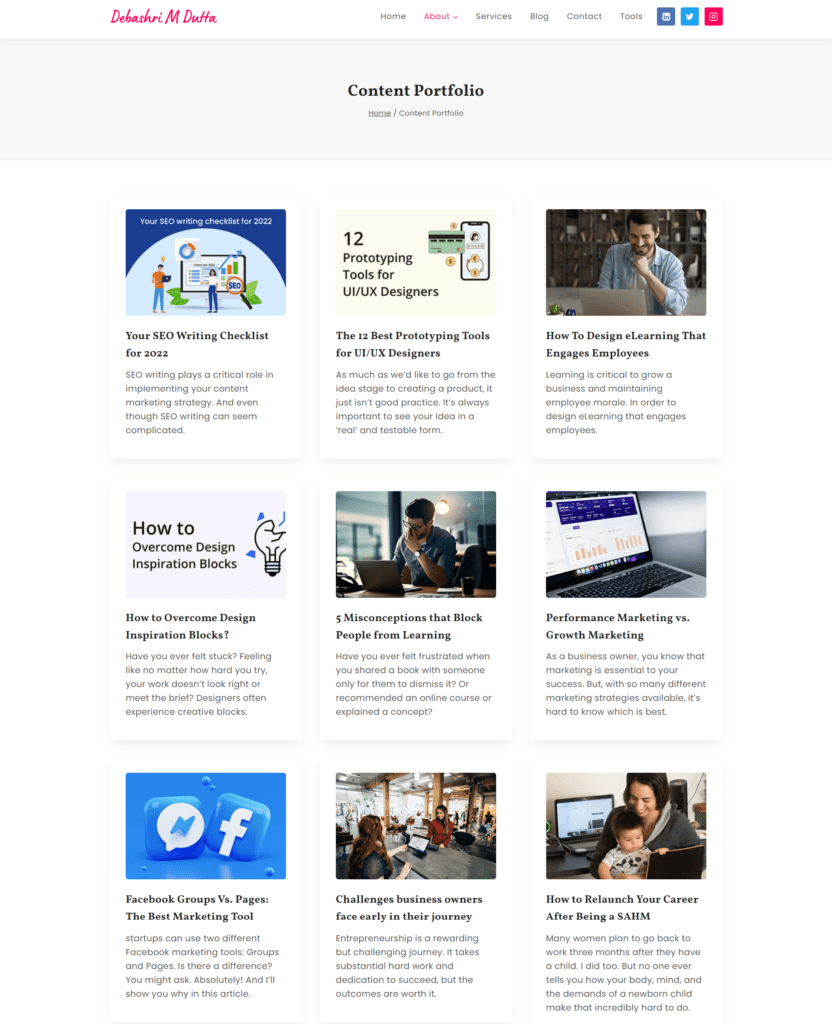Believe it or not, the competition in the freelancing realm is so tight that getting a job seems like finding a needle in a haystack.
In fact, according to statistics, 82% of the freelancing population in the US are freelance content writers.
What this means for freelance content writers looking for work is that you need to showcase your skills and experience in a way that makes them stand out.
But how do you do that? Is that even possible today? The answer is yes. And a resume and a portfolio should help you.
Both documents are important for freelancers, but which is ideal for freelance content writers?
In this blog post, we’ll look at both portfolios Vs. resumes, their uses, and identify which is best for freelance content writers.
Overview
There are two primary methods to present yourself to potential clients if you are a freelance content writer: a resume and a portfolio.
Deciding which one to use can be tricky because each has its advantages and disadvantages. While a resume is typically a one- or two-page document outlining your qualifications and experience, a portfolio is a compilation of your best work that showcases your skills and abilities.




In terms of applying for content writing jobs, both have their place. The key is understanding when and how to use each.
Here, we’ll discuss the real purpose of a resume and a portfolio, when to use them, and which is ideal for freelance content writers looking to land a job. We’ll also talk about the importance of tailoring your application materials depending on the job you’re applying to.
The Purpose of a Resume
A resume is a document that outlines a person’s professional experience, qualifications, and skills. It is an important tool you can use to market yourself when applying for jobs or freelance work. For freelance content writers, a resume serves as a way to highlight and showcase your writing experience, qualifications, and skills to potential clients.
When crafting a resume for freelance content writing gigs, it’s important to emphasize the writing experience you have and any projects you have completed related to content writing. You can also include any awards, certifications, and other professional accomplishments that could support your application. In addition, you can highlight any content writing software or tools you are familiar with that may help you in completing content writing assignments.
The obvious advantage of using a resume as a freelance content writer is that it provides potential clients with an overview of your experience, qualifications, and skills. It also helps employers quickly identify if you have the experience and qualifications to do the job. On the downside, employers may not get a full picture of your writing style from a resume.
Tips on How to Create a Resume as a Content Writer
As a content writer, you know that your resume is one of your best marketing tools, and it plays a crucial role in your job search. This document is what will get you noticed by potential employers, so it needs to showcase your skills and experience effectively.
However, with the increasing competition in the freelancing industry, creating an impressive resume that stands out from the rest can be challenging. So, we will share essential tips on how to create a resume as a content writer.
Whether you’re a seasoned content writer or just starting in the freelancing business, these tips will help you craft a resume that will catch the attention of potential employers and land you more and more clients.
- Highlight Your Writing and Editing Skills: You should emphasize the writing and editing skills you have acquired over the years on your resume. List any related courses or seminars you have taken, any awards or recognition you have received, and any publications you have written for.
- Showcase Your Knowledge and Familiarity with Different Writing Styles: If you are a content writer, chances are you have experience writing in different styles, including SEO, journalistic, technical, and creative writing. Make sure to showcase this knowledge on your resume by highlighting how your skills can be applied to different types of writing.
- Highlight Your Understanding of Digital Platforms: Content writers need to be savvy and familiar with various digital platforms used in the industry to stay up to date. If you have experience using CMS (Content Management Systems), blogging platforms, and social media platforms, make sure to list them on your resume.
- Emphasize Your Ability to Follow an Editorial Process: Content writers often need to comply and follow an editorial process, which involves writing, editing, and revising articles in accordance with an editor’s feedback. Talk about your ability to do this in your resume.
- Share Previously Completed Content Writing Projects: When you’re a content writer, sharing any previously completed content writing projects you were involved in is beneficial. This will demonstrate your style and skillset as a writer.
- List Your Other Qualifications: While being a great writer is important, content writers should also possess qualifications such as an understanding of marketing, research skills, and the ability to work quickly and efficiently. Be sure to list these qualifications on your resume as well. Soft skills can also give you an edge over other applicants.
- Organize Your Resume: To create an effective resume for freelance content writing, start by listing your educational background and any applicable work experience. Then, add any freelance writing jobs you’ve completed, including the clients you wrote for, the length of the project, and any positive feedback received. Finally, mention any writing awards or accomplishments that may make you stand out from other applicants.
- Proofread Carefully: As a writer, it’s essential that you proofread your resume carefully to ensure there are no errors or typos. This will help showcase your attention to detail and professionalism as a content writer.
When to Use a Resume
In most situations, a resume is your best job application material as a content writer. It allows you to quickly and concisely highlight your relevant skills and accomplishments. A portfolio, on the other hand, gives prospective employers a comprehensive look at your writing samples.
A resume may be particularly useful in the following scenarios:
- If you’re applying for a position that is more research-oriented, such as copywriting for a white paper. Here, your resume can support and prove that you have the research skills necessary to fulfill the role.
- If you’re just starting out as a freelance content writer. For a newbie, your resume will help illustrate why you’d be the perfect person for the job and how your education and experience have prepared you for the job.
- If you’re trying to secure a position with a highly competitive client. In this scenario, having an impressive resume may set you apart from the competition and help you get the job.
The Purpose of a Portfolio
As mentioned above, a portfolio is a collection of your best work as a freelance content writer. It showcases your skills and experience and can include a variety of content, such as blog posts, articles, whitepapers, and copywriting samples. It may also highlight other writing projects you have completed.
If you want more details, you can read about how to create a portfolio and get relevant tips and examples.
In general, a portfolio gives potential employers an idea of your writing skills and a hint of the type of work you are capable of producing. It can also be used to demonstrate your expertise in a particular topic or style of writing.
The secret to creating an effective portfolio is to focus on quality over quantity. The goal should be to showcase the best writing samples you have produced and convince potential employers that you have what it takes to fill in the role.
Like the portfolio of other professionals, there are key elements that a portfolio should have for it to stand out. And for freelance content writers, these may include the following:
- Professional biography
- Writing samples
- Client testimonials and feedback
- Links to some published works
- Description of the services offered
- Examples of research methods used
- Social media accounts
However, a portfolio can be simple, like the one by Dominic Kent in the image below. The minimum you should do is compile your work together.


Advantages and Disadvantages of Using a Portfolio
Now that we have established the purpose of a portfolio, what do you think are the advantages and disadvantages of using it alone as a freelance content writer looking for a job?
A portfolio’s main and obvious advantage is that it provides potential employers with a comprehensive overview of your writing abilities. This makes it easier for them to make an informed decision about whether or not to hire you. Additionally, having a portfolio can make it easier for you to market yourself as a freelancer and attract new clients.
However, the disadvantage of using a portfolio is that it can take significant time and effort to create and maintain. Moreover, it may not always be necessary or appropriate in certain circumstances, such as when applying for jobs that don’t require writing samples.
Tips on How to Create a Portfolio as a Content Writer
As a content writer, having a strong portfolio is of the utmost importance for you to showcase your writing skills, creativity, and expertise. It represents your work and demonstrates your ability to communicate effectively with your audience.
Then again, creating a portfolio as a content writer can be daunting, especially if you’re just starting in the field or have limited experience. But when you are able to create a portfolio that stands out, you can stand out from the competition and open up new opportunities for your career.
Here, we’ll provide tips on creating a portfolio as a content writer showcasing your unique voice, writing style, and expertise. From selecting your best work to presenting it engagingly and professionally, these tips should help you highlight your strengths as a content writer.
- Start with a Clean Slate: Before creating your portfolio, clearly and concisely define what kind of content you want to feature. Take the time to think about the pieces you want to showcase, so you can create a unified and organized portfolio.
- Showcase Your Best Work: Take the time to curate the content pieces you include in your portfolio. Only showcase your best work that reflects your writing style, strengths and skills. You may also add pieces demonstrating your knowledge of the topic and showing off your writing style.
- Add Context: Although having samples of your writing is great, providing context for each piece is of the essence. This can include anything from the length of the piece to the audience or publication it was written for and even any challenges you faced while writing it.
- Be Organized: When displaying your pieces, make sure to organize them in a way that makes sense for potential employers. Group similar content pieces together and have a consistent theme throughout the portfolio.
- Use Relevant Details: Don’t forget to include details like the date the content or article was published and any awards or recognition it received. This will give employers a complete and clearer picture of your work as a content writer.
- Include Testimonials: Include quotes or reviews from people who have worked with you on any project. These testimonials provide additional evidence that you have worked on these projects and can be a great addition to any content writer’s portfolio.
- Create an Engaging Design: Lastly, make sure your portfolio looks professional and is easy to navigate. Use design elements to make it visually appealing and add interactive features such as videos or slideshows to make it stand out from other portfolios.
- Group Your Work: Start by choosing samples of your best work and organize them into categories that make sense for the role you are applying for. For example, if you are applying for a blog writing role, you may want to create a separate folder for each blog post you’ve written and include a brief description of each one. You can also add other items, such as references from clients and links to any websites or publications you have contributed to.
- Write an Introduction: Include a short introduction at the start of your portfolio that explains who you are and what type of freelance content writing you specialize in. This will help orient potential employers to your skillset quickly and give them an idea of what they can expect from you.
- Update It Regularly. Don’t forget to update your portfolio regularly. As your skills and experience grow, so should your portfolio. Keeping it up-to-date ensures that potential employers will always have access to the best version of your work.
When to Use a Portfolio
As you know, a portfolio can be invaluable for showcasing your work and displaying your skills as a content writer. It can be the difference between getting a job or not, and having a good one is essential for any freelancer looking to build a career.
When considering whether to use a resume or a portfolio, it is important to consider the type of job that you are applying for. Generally speaking, resumes are used for more traditional roles, while portfolios are used in the creative industries. Freelance content writing tends to be more creative than traditional, so a portfolio is often the best choice.
Examples of when a portfolio might be useful include applying for freelance writing roles that are on a project basis, such as blog posts, website content, or e-books. In these cases, it is important to be able to showcase your work to potential employers and demonstrate your writing style and experience. This can easily be done with a portfolio.
The Importance of Tailoring Your Job Application Material
When applying for a freelance content writing job, you should always tailor your application materials to the position you are applying for. This means that you should consider the job requirements and customize your resume or portfolio accordingly.
The goal is to make sure your application stands out from the pool of applicants and showcases your qualifications and experience in the best way possible. To determine which approach is best for a particular situation, you should first assess what the employer is looking for in a candidate.
For example, if an employer is looking for someone with specific skills or experience, then a tailored resume or portfolio showcasing those skills and experiences may be the best approach. On the other hand, if the employer is looking for someone with general skills or experience, then a more generic resume or portfolio may be sufficient.
If you are applying for a content writing position, creating a portfolio showcasing examples of your work is a good idea. This allows employers to get an understanding of your writing style, the industries you specialize in, and your expertise.
Likewise, you can tailor your resume to highlight any relevant experience that may apply to the job you are applying for. For example, if the job requires research skills, you should include any relevant research experience in your resume.
You may not appreciate it for now. But taking the time to customize your approach based on the requirements of the position can give you a competitive edge over other applicants and increase your chances of landing the job.
Which Is Best for Freelance Content Writers?
For freelance content writers, resumes and portfolios can be beneficial tools in the job search. A resume highlights your qualifications, past experiences, and skills related to a specific role or industry. It should provide enough detail to explain why you would be a good fit for the job. On the other hand, a portfolio is a collection of samples of your work that demonstrate your writing abilities and provide potential employers with an insight into your creative approach.
When deciding between a resume and a portfolio, always consider the nature of the position you’re applying for. A resume will be more useful than a portfolio if the job requires prior experience and specific skill sets. However, a portfolio will be more appropriate if the position requires creativity and demonstration of writing ability.
Tailoring your job application materials to each position you apply for is also important. This means tailoring your resume to the job description and curating your portfolio samples to show your best work that’s relevant to the job.
Overall, the decision of which application tool to use depends on the type of job and what skills you want to showcase. Both resumes and portfolios can be effective tools in the job search process for freelance content writers. However, no matter which routes you choose, make sure to tailor your materials to each job application to maximize your chances of success.
Guest Author: Dahlia Keen
Dahlia Keen is passionate about helping people find meaningful work in a career they enjoy. A creative writer for ResumeKit.com, she is backed by years of experience writing resumes for diverse industries, and she has helped hundreds of professionals land their dream job.







